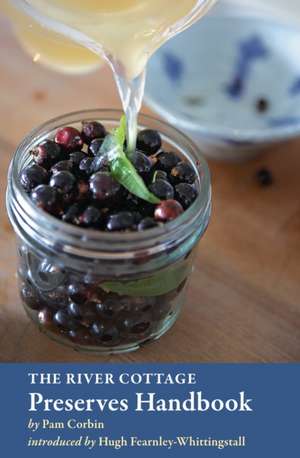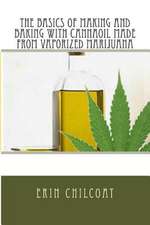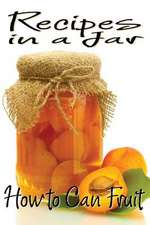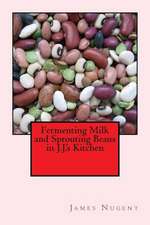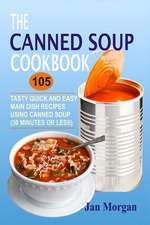The River Cottage Preserves Handbook
Autor Pam Corbin Hugh Fearnley-Whittingstallen Limba Engleză Hardback – 31 mai 2010
Preț: 127.68 lei
Nou
Puncte Express: 192
Preț estimativ în valută:
24.44€ • 25.42$ • 20.48£
24.44€ • 25.42$ • 20.48£
Carte disponibilă
Livrare economică 21 februarie-07 martie
Preluare comenzi: 021 569.72.76
Specificații
ISBN-13: 9781580081726
ISBN-10: 158008172X
Pagini: 216
Ilustrații: 102 4-COLOR PHOTOGRAPHS
Dimensiuni: 142 x 213 x 27 mm
Greutate: 0.51 kg
Editura: Ten Speed Press
ISBN-10: 158008172X
Pagini: 216
Ilustrații: 102 4-COLOR PHOTOGRAPHS
Dimensiuni: 142 x 213 x 27 mm
Greutate: 0.51 kg
Editura: Ten Speed Press
Notă biografică
PAM CORBIN has been making preserves for as long as she can remember, and for more than twenty years her passion has been her business. Pam and her husband, Hugh, moved to Devon where they bought an old pig farm and converted it into a small jam factory. Using only wholesome, seasonal ingredients, their products soon became firm favorites with jam-lovers the world over. Pam has now hung up her professional wooden spoon but continues to "jam" at home. She also works closely with the River Cottage team, making seasonal goodies using fruit, vegetables, herbs, and flowers from her own garden, and from the fields and hedgerows.
HUGH FEARNLEY-WHITTINGSTALL is a renowned British broadcaster, writer, farmer, educator, and campaigner for real food. The author of seven books, including the James Beard Award-winning River Cottage Meat Book, Hugh lives with his family on the River Cottage farm.
HUGH FEARNLEY-WHITTINGSTALL is a renowned British broadcaster, writer, farmer, educator, and campaigner for real food. The author of seven books, including the James Beard Award-winning River Cottage Meat Book, Hugh lives with his family on the River Cottage farm.
Extras
Seasonality
Preserving the bounties of our fruitful summer and autumn was normal -- a way of life -- not so many years ago. It was essential to stock up the larder for leaner months, when fresh food was scarce or unavailable and the sealed bottles and jars full of summer would help to allay the monotony of the winter diet. If soft summer currants and berries -- and gluts of sweet-smelling tomatoes and baskets of vegetables -- weren’t kept in some form or another, then there would be no summer produce until the following year. There was no nipping down to the supermarket to buy, in the midst of January, a basket of strawberries or even a bag of tomatoes.
You don’t need to turn the clock back far, just a couple of generations to the 1950s, when to own a home refrigerator or a freezer was considered opulent, and of course fresh foods didn’t arrive each day of the week, each week of the year, by air and sea from all corners of the globe to flood shop shelves with produce that would otherwise be considered out of season.
The rationing of food in Britain that began during wartime finally finished in July 1954, nine years after the war had ended. The war years had seen the government allocating sugar to the Women’s Institute (WI) for jam making so that surplus produce did not go to waste. The extent of food preservation by the WI did not stop at jam making; these resolute ladies also canned fruit and vegetables for the national food supply. The end to those long years of rationing coincided with an increase in the variety of imported foods readily available throughout the year. Unquestionably, for many this has meant that the structure and meaningful importance of working and living the seasons, along with the necessity to preserve and not waste, have vanished from everyday life.
Following the seasons
Food is never more flavorsome or as good as when it is fresh and in season, making the riches of a good harvest a just reward for anybody who is prepared to take notice of and be guided by the seasons. For me, there’s not much to better a freshly dug new potato cooked up with a sprig of garden mint, and how these earthy roots can be thought of as humble is inexplicable, as they are a staple food worldwide. If stored correctly (dark and between 40° and 50°F), their firm and starchy bodies will keep naturally for months without any further action to preserve them.
Or, what could surpass devouring a plateful of freshly picked raspberries? These soft, juicy berries, however, will keep for barely a day or two before they begin to deteriorate, so action needs to be speedy to preserve them at their best. Raspberries are a wonderfully useful preserving ingredient, for they can be transformed into blissful jam, canned, turned into berry cordial, or used to make fruity vinegar, all to be put away and enjoyed later in the year.
By the very nature of the variable climate linked with each of the four seasons, much homegrown produce is available for limited periods, sometimes just a few swift weeks of the year, when crops of gluttish proportion are available to feast upon fresh and any surplus will be at its best preserved in some way or another. Ideally, produce to be preserved should be as fresh and local as possible, so every tasty scrap of its character is unmistakably captured. However, there are a few exceptions to the local rule, and until we see citrus groves swathing the land, the long-standing tradition of making marmalade to preserve the bitter Seville orange will continue, in addition to the use of tart, acidic lemon in all number of preserving and culinary recipes.
The familiarity of the pattern of the seasons and what each offers is fundamental to understanding how the preserving year is entwined with the growing seasons. The seasonal performance is undoubtedly the greatest show on earth: a perennial show in four parts, running for 365 days of the year with every month taking a worthy and significant role, where complementary ingredients brush shoulders at their growing time. You’ll find that elderflowers add muscat perfume to gooseberries, pectin-rich red currants combine with low-pectin strawberries, and soft, fleshy apples partner seedy blackberries perfectly at autumn time.
The long slender stalks of rhubarb bridge the beginning and the end of each yearly cycle, starting around the time of the spring equinox, when the sun makes the first of its biannual crossings over the equator and the lengths of day and night are more or less equal. It is now that the first crinkled, sulfur-yellow rhubarb leaves begin to push their way up from the sleepy earth, unfurling to spread their towering umbrella leaves over silken red-green shoots. From here on, and until the quiescence of sleeping winter, there is usually something budding up and getting ready to yield some form of crop for us to harvest, so a sharp eye needs to be employed to avoid missing any of the seasonal gifts each month offers.
Spring
The spring months of April and May are the wake-up time, heralding the burst of new growth from latent pinkish-tinged buds and shoots that rapidly change into blossoms or velvety spring-green leaves. The feathery soft green foliage of the native beech begins to spill out from hedgerows in late April and early May, just ahead of the elderflowers, who run riot in a show-off way just about everywhere later in the month. Patches of nettles and wild garlic appear on sheltered banks, the tender young leaves just right to be turned into zesty pesto. Protected pockets of land will allow the first tiny green gooseberries of the season to be picked, and like the long red-green rhubarb stalks, these berries are sharp and tart too, almost as if it is nature’s way of arousing our dulled taste buds, stimulating and preparing them for the rush of flavors to come. In preserving terms, these two months are still quite a lazy time, a teaser for the months ahead, but they are by no means idle. Use this time to check out your preserving gear (jars, bottles, lids, and things) and make sure your stocks of sugar, spices, and vinegar are plentiful for when the real season kicks off.
Summer
In June, we encounter the summer solstice, when the daylight hours are at their maximum and the increasing warmth gives rise to a frenzy of growing in all shapes and colors. We see the start of the soft fruit season with strings of shimmering red currants and the early varieties of strawberries and raspberries producing their first sweet berries. Aromatic herbs make themselves known, and their heady, sweet-smelling leaves can be used to augment vinegars and oils and to flavor pesto and relishes. The hedgerow shyly reveals diminutive silver-gray blackberry buds, while the petals of Rosa canina (dog rose) can be gathered to add fragrance to jams, jellies, cordials, and spirits. Down in the vegetable garden, the first fattening roots of sweet beets and the swollen heads of Florence fennel will be beginning to show.
July is the month when the wooden spoon begins to get busy. The early soft berries and currants of June extend to welcome main-crop varieties along with other currant and berry friends; black currants, blueberries, tayberries, and loganberries crop plentifully, and gooseberries reach sweet maturity to end their productive reign. The silver-gray blackberry buds of June break into pink-tinged white flowers, soon to metamorphose into the unmistakable drupelets of indigenous blackberries. Look closely at the elder bush and you’ll see a mass of green underripe berries, which before long will glisten red-black as they ripen. Rosehips and hawthorn berries are like hedgerow chameleons, disguised in their leafy green coats before they first tinge bronze and then blush red for their autumnal show. Cherries, the first of the stone fruits, will be ready, but be quick -- they won’t last long, and eagle-eyed birds will be waiting to gorge upon them. Plums are beginning to swell, but it won’t be until late in the month or the beginning of August that the early varieties of these orchard fruits will be ready.
August is the true glut month, when green beans, zucchini, tomatoes, cucumbers, and summer vegetables invariably oversupply, resulting in a glorious month to preserve as much as possible. The summer-fruiting raspberries are soon replaced by the first flush of blackberries -- always the sweetest and juiciest of the year. Watch out for hanging clusters of scarlet rowans, the berries of the mountain ash, for these, combined with a handful of crab apples, will make an outstanding jelly of carnelian color.
Autumn
In September, you’ll find your back step will become a home for refugee fruit, stuffed into bags and left by well-meaning friends who expect you to make all sorts of magnificent jams, jellies, and other preserves. As you try to make sure all is safely gathered before the cooler and shorter days of autumn set in, this month might seem a race against time. But don’t panic, you’ll find that summer squash, onions, apples, pears, and others have developed protective winter coats and, if carefully stored, will keep for a month or two, to use later in the year.
Orchard fruits will now be ripening. Plums, apples, and pears yield freely, ahead of the fragrant quince ready at the tail end of the month -- watch out though, for too much moisture will make these golden beauties split. For wild food foragers, hedgerows are ablaze with color, intense with berries and fruits of all kinds; blackberries, rosehips, hawthorn berries, elderberries, scabby crab apples, and clusters of hazelnuts adorn native trees and bushes.
From here on, things really do begin to slow up. Much of the autumn harvest will be past its best. The woodland birds will have feasted well upon the hedgerow spread. Apples and pears are still plentiful to turn into Christmas mincemeat or spicy chutney, and onions pickled now will be just right for the festive season. Sweet chestnuts, split from spiky armor, can be found in heaps of fallen leaves, while raspberries, of the autumn kind, stretch berry-picking to this time.
Winter
As the year spins toward the winter solstice, the shorter, darkening days and the lack of sunlight hours allow the earth to rest from growing. The dormancy of the winter begins and only hardy leeks, blue-green brassicas, and a few rooty crops survive the cold. But still, within the cycle of the seasonal preserving year, there are two highlights yet to come. The bitter marmalade oranges from Seville arrive in early January, turning this month into a preserving stronghold of the year, when steamy citrus vapors fill our kitchens and larder shelves are replenished with jars of golden, amber, and tawny marmalade to last the year ahead.
Then finally, early rhubarb arrives to carry us through to the next perennial cycle. From late January to early March in darkened sheds and under tall forcing pots, the leaves force upward to boast the beauty of their slender, translucent pink stalks, heralding the start of another seasonal year.
Seville orange marmalade
Season: mid-January to February
The bitter Seville orange is the most traditional and arguably the finest marmalade fruit of all. Only available for a few short weeks starting in mid-January, this knobbly, often misshapen orange has a unique aromatic quality and is very rich in pectin. However, you can use almost any citrus fruit to make good marmalade -- consider sweet oranges, blood oranges, grapefruit, limes, clementines, kumquats, or a combination of two or three (see my suggested variations on p. 46).
There are two basic ways of making marmalade. My first choice is the sliced fruit method, which involves cutting the raw peel into shreds before cooking. I find this technique produces a brighter, clearer result. However, the whole fruit method, in which the fruit is boiled whole before being cut up, is easier and less time-consuming. It tends to create a darker, less delicate preserve -- but that, of course, might be exactly what you want. I’ve given you both methods here.
Sliced fruit method
Makes five to six 12-ounce jars
21/4 pounds Seville oranges
1/3 cup lemon juice
10 cups Demerara sugar
Scrub the oranges, remove the buttons at the top of the fruit, then cut in half. Squeeze out the juice and keep to one side. Using a sharp knife, slice the peel, pith and all, into thin, medium, or chunky shreds, according to your preference. Put the sliced peel into a bowl with the orange juice and cover with 10 cups of water. Let soak overnight or for up to 24 hours.
Transfer the whole mixture to a preserving pan, bring to a boil, then simmer slowly, covered, until the peel is tender. This should take approximately 2 hours, by which time the contents of the pan will have reduced by about one-third.
Stir in the lemon juice and sugar. Bring the marmalade to a boil, stirring until the sugar has dissolved. Boil rapidly until the setting point is reached (see p. 41), 20 to 25 minutes. Remove from the heat. Let cool for 8 to 10 minutes -- a little longer if the peel is in very chunky pieces -- then stir gently to disperse any scum. Pour into warm, sterilized jars and seal immediately (see pp. 21--22). Use within 2 years.
Whole fruit method
Makes five 12-ounce jars
21/4 pounds Seville oranges
1/3 cup lemon juice
10 cups granulated sugar
Scrub the oranges, remove the buttons at the top, and put the whole oranges into a preserving pan with 10 cups of water. Bring to a boil, then simmer, covered, for 2 to 2½ hours, until the orange skins are tender and can be pierced easily with a fork.
When cool enough to handle, take the oranges out. Measure and keep the cooking water -- you should have about 7 cups. Bring it up to this amount with more water if you have less, or boil to reduce if you have more.
Cut the oranges in half and remove the seeds with a fork, flicking them into a bowl. Strain any juice from the seeds back into the cooking water, then discard the seeds.
Meanwhile, cut up the orange peel and flesh into thick, medium, or thin shreds. Put the cut-up fruit into the strained cooking liquid. Add the lemon juice and sugar and bring to a boil, stirring until the sugar has completely dissolved. Bring to a rolling boil and boil rapidly until the setting point is reached (see p. 41), 10 to 15 minutes.
Let cool for 10 to 12 minutes -- a little longer if you’ve cut the peel into very chunky pieces -- then stir gently to disperse any scum. Pour into warm, sterilized jars and seal immediately (see pp. 21--22). Use within 2 years.
Variations
You can use both methods for making many other delicious marmalades:
Lemon marmalade with honey Use 21/4 pounds of lemons instead of oranges, and omit the extra lemon juice. Replace 11/4 cups of the sugar with 3/4 cup of honey, adding it at the same time.
Three-fruit marmalade Use a mixture of grapefruit, lemons, and sweet oranges to make a total of 21/4 pounds of fruit.
Ruby red marmalade Both pink grapefruit and blood oranges make wonderful marmalades, though I prefer to use the sliced fruit method for these fruits. Add 3 tablespoons of lemon juice to every pound of fruit.
Seville and ginger marmalade Replace 11/4 cups of the sugar with 9 ounces of chopped crystallized ginger, adding it along with the sugar.
Whiskey marmalade Add 1/4 cup of whiskey to the marmalade at the end of cooking.
P.S. Don’t limit marmalade to the breakfast table, for its traits and qualities can be well used in other culinary ways. I like to replace candied peel in fruitcakes with a tablespoonful or two of marmalade, and I always add some to my Christmas mincemeat (p. 74). Marmalade makes a marvelous glaze for oven-baked ham, as well as sweet-and-sour chicken or pork dishes. Best of all, 3 or 4 tablespoonfuls will make a glorious golden topping for a good old-fashioned steamed pudding.
P.P.S. For generations, marmalade makers have cooked up the mass of seeds found inside citrus fruits in the belief that they are full of pectin. However, most of the pectin is actually found in the citrus peel, and I rely purely on this for the setting power in my marmalades.
Preserving the bounties of our fruitful summer and autumn was normal -- a way of life -- not so many years ago. It was essential to stock up the larder for leaner months, when fresh food was scarce or unavailable and the sealed bottles and jars full of summer would help to allay the monotony of the winter diet. If soft summer currants and berries -- and gluts of sweet-smelling tomatoes and baskets of vegetables -- weren’t kept in some form or another, then there would be no summer produce until the following year. There was no nipping down to the supermarket to buy, in the midst of January, a basket of strawberries or even a bag of tomatoes.
You don’t need to turn the clock back far, just a couple of generations to the 1950s, when to own a home refrigerator or a freezer was considered opulent, and of course fresh foods didn’t arrive each day of the week, each week of the year, by air and sea from all corners of the globe to flood shop shelves with produce that would otherwise be considered out of season.
The rationing of food in Britain that began during wartime finally finished in July 1954, nine years after the war had ended. The war years had seen the government allocating sugar to the Women’s Institute (WI) for jam making so that surplus produce did not go to waste. The extent of food preservation by the WI did not stop at jam making; these resolute ladies also canned fruit and vegetables for the national food supply. The end to those long years of rationing coincided with an increase in the variety of imported foods readily available throughout the year. Unquestionably, for many this has meant that the structure and meaningful importance of working and living the seasons, along with the necessity to preserve and not waste, have vanished from everyday life.
Following the seasons
Food is never more flavorsome or as good as when it is fresh and in season, making the riches of a good harvest a just reward for anybody who is prepared to take notice of and be guided by the seasons. For me, there’s not much to better a freshly dug new potato cooked up with a sprig of garden mint, and how these earthy roots can be thought of as humble is inexplicable, as they are a staple food worldwide. If stored correctly (dark and between 40° and 50°F), their firm and starchy bodies will keep naturally for months without any further action to preserve them.
Or, what could surpass devouring a plateful of freshly picked raspberries? These soft, juicy berries, however, will keep for barely a day or two before they begin to deteriorate, so action needs to be speedy to preserve them at their best. Raspberries are a wonderfully useful preserving ingredient, for they can be transformed into blissful jam, canned, turned into berry cordial, or used to make fruity vinegar, all to be put away and enjoyed later in the year.
By the very nature of the variable climate linked with each of the four seasons, much homegrown produce is available for limited periods, sometimes just a few swift weeks of the year, when crops of gluttish proportion are available to feast upon fresh and any surplus will be at its best preserved in some way or another. Ideally, produce to be preserved should be as fresh and local as possible, so every tasty scrap of its character is unmistakably captured. However, there are a few exceptions to the local rule, and until we see citrus groves swathing the land, the long-standing tradition of making marmalade to preserve the bitter Seville orange will continue, in addition to the use of tart, acidic lemon in all number of preserving and culinary recipes.
The familiarity of the pattern of the seasons and what each offers is fundamental to understanding how the preserving year is entwined with the growing seasons. The seasonal performance is undoubtedly the greatest show on earth: a perennial show in four parts, running for 365 days of the year with every month taking a worthy and significant role, where complementary ingredients brush shoulders at their growing time. You’ll find that elderflowers add muscat perfume to gooseberries, pectin-rich red currants combine with low-pectin strawberries, and soft, fleshy apples partner seedy blackberries perfectly at autumn time.
The long slender stalks of rhubarb bridge the beginning and the end of each yearly cycle, starting around the time of the spring equinox, when the sun makes the first of its biannual crossings over the equator and the lengths of day and night are more or less equal. It is now that the first crinkled, sulfur-yellow rhubarb leaves begin to push their way up from the sleepy earth, unfurling to spread their towering umbrella leaves over silken red-green shoots. From here on, and until the quiescence of sleeping winter, there is usually something budding up and getting ready to yield some form of crop for us to harvest, so a sharp eye needs to be employed to avoid missing any of the seasonal gifts each month offers.
Spring
The spring months of April and May are the wake-up time, heralding the burst of new growth from latent pinkish-tinged buds and shoots that rapidly change into blossoms or velvety spring-green leaves. The feathery soft green foliage of the native beech begins to spill out from hedgerows in late April and early May, just ahead of the elderflowers, who run riot in a show-off way just about everywhere later in the month. Patches of nettles and wild garlic appear on sheltered banks, the tender young leaves just right to be turned into zesty pesto. Protected pockets of land will allow the first tiny green gooseberries of the season to be picked, and like the long red-green rhubarb stalks, these berries are sharp and tart too, almost as if it is nature’s way of arousing our dulled taste buds, stimulating and preparing them for the rush of flavors to come. In preserving terms, these two months are still quite a lazy time, a teaser for the months ahead, but they are by no means idle. Use this time to check out your preserving gear (jars, bottles, lids, and things) and make sure your stocks of sugar, spices, and vinegar are plentiful for when the real season kicks off.
Summer
In June, we encounter the summer solstice, when the daylight hours are at their maximum and the increasing warmth gives rise to a frenzy of growing in all shapes and colors. We see the start of the soft fruit season with strings of shimmering red currants and the early varieties of strawberries and raspberries producing their first sweet berries. Aromatic herbs make themselves known, and their heady, sweet-smelling leaves can be used to augment vinegars and oils and to flavor pesto and relishes. The hedgerow shyly reveals diminutive silver-gray blackberry buds, while the petals of Rosa canina (dog rose) can be gathered to add fragrance to jams, jellies, cordials, and spirits. Down in the vegetable garden, the first fattening roots of sweet beets and the swollen heads of Florence fennel will be beginning to show.
July is the month when the wooden spoon begins to get busy. The early soft berries and currants of June extend to welcome main-crop varieties along with other currant and berry friends; black currants, blueberries, tayberries, and loganberries crop plentifully, and gooseberries reach sweet maturity to end their productive reign. The silver-gray blackberry buds of June break into pink-tinged white flowers, soon to metamorphose into the unmistakable drupelets of indigenous blackberries. Look closely at the elder bush and you’ll see a mass of green underripe berries, which before long will glisten red-black as they ripen. Rosehips and hawthorn berries are like hedgerow chameleons, disguised in their leafy green coats before they first tinge bronze and then blush red for their autumnal show. Cherries, the first of the stone fruits, will be ready, but be quick -- they won’t last long, and eagle-eyed birds will be waiting to gorge upon them. Plums are beginning to swell, but it won’t be until late in the month or the beginning of August that the early varieties of these orchard fruits will be ready.
August is the true glut month, when green beans, zucchini, tomatoes, cucumbers, and summer vegetables invariably oversupply, resulting in a glorious month to preserve as much as possible. The summer-fruiting raspberries are soon replaced by the first flush of blackberries -- always the sweetest and juiciest of the year. Watch out for hanging clusters of scarlet rowans, the berries of the mountain ash, for these, combined with a handful of crab apples, will make an outstanding jelly of carnelian color.
Autumn
In September, you’ll find your back step will become a home for refugee fruit, stuffed into bags and left by well-meaning friends who expect you to make all sorts of magnificent jams, jellies, and other preserves. As you try to make sure all is safely gathered before the cooler and shorter days of autumn set in, this month might seem a race against time. But don’t panic, you’ll find that summer squash, onions, apples, pears, and others have developed protective winter coats and, if carefully stored, will keep for a month or two, to use later in the year.
Orchard fruits will now be ripening. Plums, apples, and pears yield freely, ahead of the fragrant quince ready at the tail end of the month -- watch out though, for too much moisture will make these golden beauties split. For wild food foragers, hedgerows are ablaze with color, intense with berries and fruits of all kinds; blackberries, rosehips, hawthorn berries, elderberries, scabby crab apples, and clusters of hazelnuts adorn native trees and bushes.
From here on, things really do begin to slow up. Much of the autumn harvest will be past its best. The woodland birds will have feasted well upon the hedgerow spread. Apples and pears are still plentiful to turn into Christmas mincemeat or spicy chutney, and onions pickled now will be just right for the festive season. Sweet chestnuts, split from spiky armor, can be found in heaps of fallen leaves, while raspberries, of the autumn kind, stretch berry-picking to this time.
Winter
As the year spins toward the winter solstice, the shorter, darkening days and the lack of sunlight hours allow the earth to rest from growing. The dormancy of the winter begins and only hardy leeks, blue-green brassicas, and a few rooty crops survive the cold. But still, within the cycle of the seasonal preserving year, there are two highlights yet to come. The bitter marmalade oranges from Seville arrive in early January, turning this month into a preserving stronghold of the year, when steamy citrus vapors fill our kitchens and larder shelves are replenished with jars of golden, amber, and tawny marmalade to last the year ahead.
Then finally, early rhubarb arrives to carry us through to the next perennial cycle. From late January to early March in darkened sheds and under tall forcing pots, the leaves force upward to boast the beauty of their slender, translucent pink stalks, heralding the start of another seasonal year.
Seville orange marmalade
Season: mid-January to February
The bitter Seville orange is the most traditional and arguably the finest marmalade fruit of all. Only available for a few short weeks starting in mid-January, this knobbly, often misshapen orange has a unique aromatic quality and is very rich in pectin. However, you can use almost any citrus fruit to make good marmalade -- consider sweet oranges, blood oranges, grapefruit, limes, clementines, kumquats, or a combination of two or three (see my suggested variations on p. 46).
There are two basic ways of making marmalade. My first choice is the sliced fruit method, which involves cutting the raw peel into shreds before cooking. I find this technique produces a brighter, clearer result. However, the whole fruit method, in which the fruit is boiled whole before being cut up, is easier and less time-consuming. It tends to create a darker, less delicate preserve -- but that, of course, might be exactly what you want. I’ve given you both methods here.
Sliced fruit method
Makes five to six 12-ounce jars
21/4 pounds Seville oranges
1/3 cup lemon juice
10 cups Demerara sugar
Scrub the oranges, remove the buttons at the top of the fruit, then cut in half. Squeeze out the juice and keep to one side. Using a sharp knife, slice the peel, pith and all, into thin, medium, or chunky shreds, according to your preference. Put the sliced peel into a bowl with the orange juice and cover with 10 cups of water. Let soak overnight or for up to 24 hours.
Transfer the whole mixture to a preserving pan, bring to a boil, then simmer slowly, covered, until the peel is tender. This should take approximately 2 hours, by which time the contents of the pan will have reduced by about one-third.
Stir in the lemon juice and sugar. Bring the marmalade to a boil, stirring until the sugar has dissolved. Boil rapidly until the setting point is reached (see p. 41), 20 to 25 minutes. Remove from the heat. Let cool for 8 to 10 minutes -- a little longer if the peel is in very chunky pieces -- then stir gently to disperse any scum. Pour into warm, sterilized jars and seal immediately (see pp. 21--22). Use within 2 years.
Whole fruit method
Makes five 12-ounce jars
21/4 pounds Seville oranges
1/3 cup lemon juice
10 cups granulated sugar
Scrub the oranges, remove the buttons at the top, and put the whole oranges into a preserving pan with 10 cups of water. Bring to a boil, then simmer, covered, for 2 to 2½ hours, until the orange skins are tender and can be pierced easily with a fork.
When cool enough to handle, take the oranges out. Measure and keep the cooking water -- you should have about 7 cups. Bring it up to this amount with more water if you have less, or boil to reduce if you have more.
Cut the oranges in half and remove the seeds with a fork, flicking them into a bowl. Strain any juice from the seeds back into the cooking water, then discard the seeds.
Meanwhile, cut up the orange peel and flesh into thick, medium, or thin shreds. Put the cut-up fruit into the strained cooking liquid. Add the lemon juice and sugar and bring to a boil, stirring until the sugar has completely dissolved. Bring to a rolling boil and boil rapidly until the setting point is reached (see p. 41), 10 to 15 minutes.
Let cool for 10 to 12 minutes -- a little longer if you’ve cut the peel into very chunky pieces -- then stir gently to disperse any scum. Pour into warm, sterilized jars and seal immediately (see pp. 21--22). Use within 2 years.
Variations
You can use both methods for making many other delicious marmalades:
Lemon marmalade with honey Use 21/4 pounds of lemons instead of oranges, and omit the extra lemon juice. Replace 11/4 cups of the sugar with 3/4 cup of honey, adding it at the same time.
Three-fruit marmalade Use a mixture of grapefruit, lemons, and sweet oranges to make a total of 21/4 pounds of fruit.
Ruby red marmalade Both pink grapefruit and blood oranges make wonderful marmalades, though I prefer to use the sliced fruit method for these fruits. Add 3 tablespoons of lemon juice to every pound of fruit.
Seville and ginger marmalade Replace 11/4 cups of the sugar with 9 ounces of chopped crystallized ginger, adding it along with the sugar.
Whiskey marmalade Add 1/4 cup of whiskey to the marmalade at the end of cooking.
P.S. Don’t limit marmalade to the breakfast table, for its traits and qualities can be well used in other culinary ways. I like to replace candied peel in fruitcakes with a tablespoonful or two of marmalade, and I always add some to my Christmas mincemeat (p. 74). Marmalade makes a marvelous glaze for oven-baked ham, as well as sweet-and-sour chicken or pork dishes. Best of all, 3 or 4 tablespoonfuls will make a glorious golden topping for a good old-fashioned steamed pudding.
P.P.S. For generations, marmalade makers have cooked up the mass of seeds found inside citrus fruits in the belief that they are full of pectin. However, most of the pectin is actually found in the citrus peel, and I rely purely on this for the setting power in my marmalades.
Recenzii
“For a touch of the homemade every day, try the River Cottage handbooks.”
—Everyday Food, Favorite New Cookbooks, December 2010
“Be prepared to make space on your cookbook shelf for these practical, passionate guides. . . . Corbin demystifies the preserving process in this authoritative, and beautiful, book.”
—Oregonian, 8/3/10
“A canning and preserving book for the home cook who likely wouldn't call themselves the ‘canning’ type. . . . Infinitely more engaging than your average American canning book, such as Better Homes & Gardens You Can Can!"
—LA Weekly, 6/28/10
"If you think of the best in homemade jams and preservers and the pleasure in eating your own produce, then you are ready for this book."
—Super Chef blog, 6/22/10
“These compact yet comprehensive hardcover volumes, part of a series written by experts in the River Cottage fold, inspire and instruct with their English charm, deploying a chatty hand-holding that nudges you through the process. The head River Cottage baker, Daniel Stevens, who put together THE RIVER COTTAGE BREAD HANDBOOK spends over 40 pages on mastering the basic loaf. His kneading explanation was so clear I didn’t need to constantly refer to the photos; and it taught me some new tricks. . . .This wide-ranging book inspires exploration, and not just because I’ll soon be able to slather my warm Scottish oatcakes, roti and even bagels with my own jam, thanks to THE RIVER COTTAGE PRESERVES HANDBOOK. Here Pam Corbin, who runs the Preserving Days at River Cottage, explains the fundamentals of jam, jelly, chutney, cordials, pickles, sauces and more in a demystifying manner. . . . Recipes for hearty ale chutney, spring rhubarb relish and Hugh’s prizewinning raspberry fridge jam are within delicious reach.”
—NY Times Book Review, Summer Reading Issue, Cookbook Roundup, 6/6/10
“Pam’s approach is . . . encouraging and adventurous. In this inspiring book she will show you the ropes and then give you the reins. I’m absolutely sure you will enjoy the ride.”
—Hugh Fearnley-Whittingstall, from the Introduction
—Everyday Food, Favorite New Cookbooks, December 2010
“Be prepared to make space on your cookbook shelf for these practical, passionate guides. . . . Corbin demystifies the preserving process in this authoritative, and beautiful, book.”
—Oregonian, 8/3/10
“A canning and preserving book for the home cook who likely wouldn't call themselves the ‘canning’ type. . . . Infinitely more engaging than your average American canning book, such as Better Homes & Gardens You Can Can!"
—LA Weekly, 6/28/10
"If you think of the best in homemade jams and preservers and the pleasure in eating your own produce, then you are ready for this book."
—Super Chef blog, 6/22/10
“These compact yet comprehensive hardcover volumes, part of a series written by experts in the River Cottage fold, inspire and instruct with their English charm, deploying a chatty hand-holding that nudges you through the process. The head River Cottage baker, Daniel Stevens, who put together THE RIVER COTTAGE BREAD HANDBOOK spends over 40 pages on mastering the basic loaf. His kneading explanation was so clear I didn’t need to constantly refer to the photos; and it taught me some new tricks. . . .This wide-ranging book inspires exploration, and not just because I’ll soon be able to slather my warm Scottish oatcakes, roti and even bagels with my own jam, thanks to THE RIVER COTTAGE PRESERVES HANDBOOK. Here Pam Corbin, who runs the Preserving Days at River Cottage, explains the fundamentals of jam, jelly, chutney, cordials, pickles, sauces and more in a demystifying manner. . . . Recipes for hearty ale chutney, spring rhubarb relish and Hugh’s prizewinning raspberry fridge jam are within delicious reach.”
—NY Times Book Review, Summer Reading Issue, Cookbook Roundup, 6/6/10
“Pam’s approach is . . . encouraging and adventurous. In this inspiring book she will show you the ropes and then give you the reins. I’m absolutely sure you will enjoy the ride.”
—Hugh Fearnley-Whittingstall, from the Introduction
Cuprins
Contents
Introduction 6
Seasonality 8
The Rules 16
Jams & Jellies 34
Pickles, Chutneys & Relishes 84
Cordials, Fruit Liqueurs & Vinegars 120
Canned Fruits 150
Sauces, Ketchups & Oil-based Preserves 178
Notes to the U.S. Edition 200
Acknowledgments 204
Index 207
Introduction 6
Seasonality 8
The Rules 16
Jams & Jellies 34
Pickles, Chutneys & Relishes 84
Cordials, Fruit Liqueurs & Vinegars 120
Canned Fruits 150
Sauces, Ketchups & Oil-based Preserves 178
Notes to the U.S. Edition 200
Acknowledgments 204
Index 207
Descriere
In this 75-recipe collection, River Cottage Farm master-preserver Corbin introduces a world of jams, jellies, butters, curds, pickles, chutneys, cordials, liqueurs, vinegars, and sauces that can be made from local produce throughout the year.
